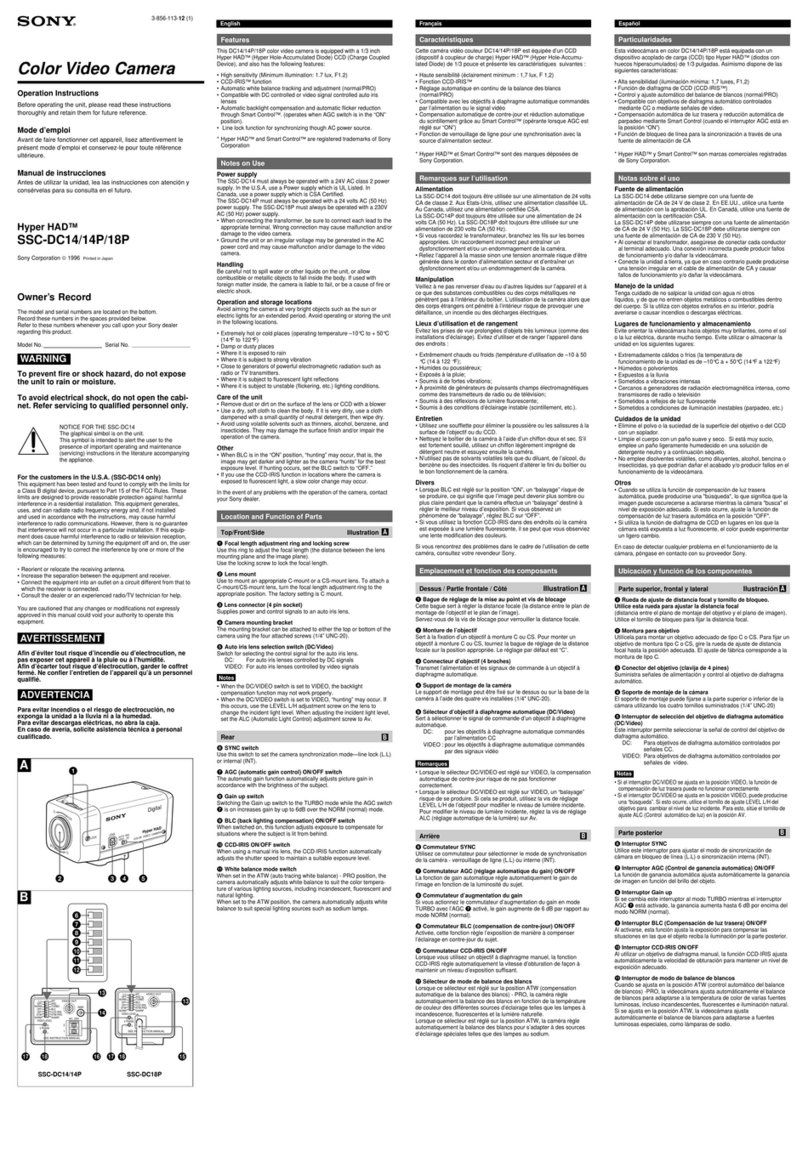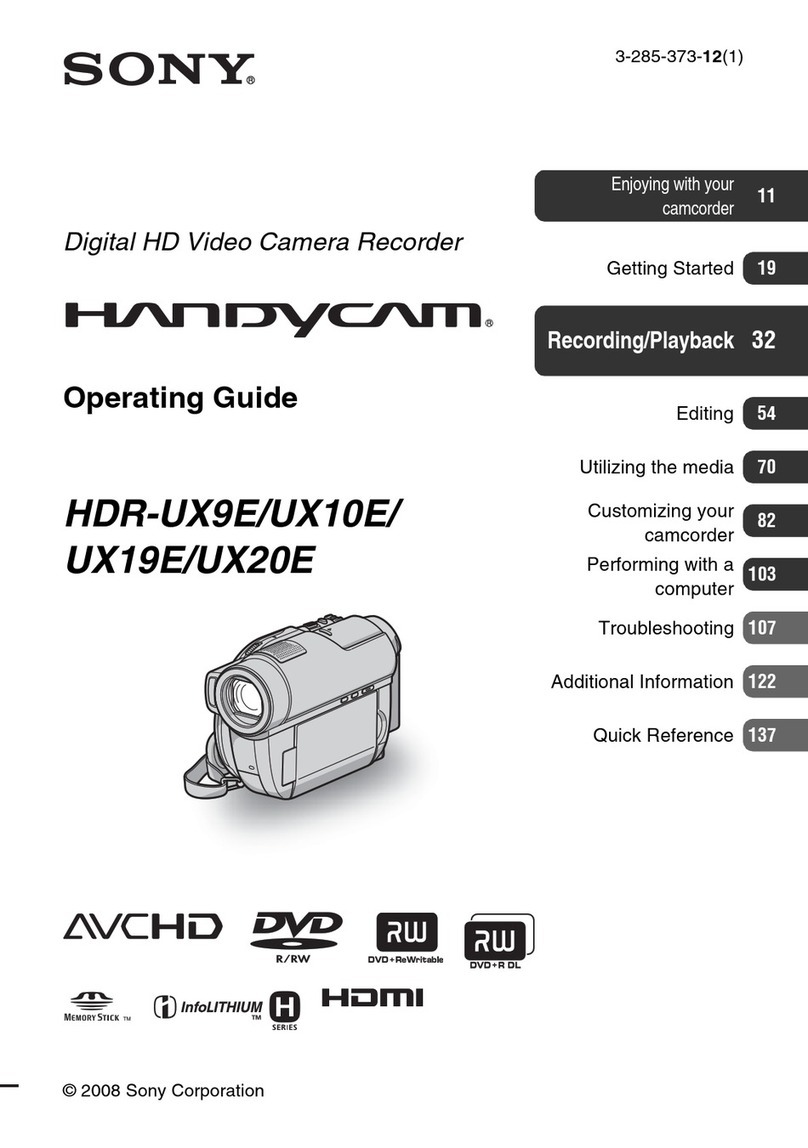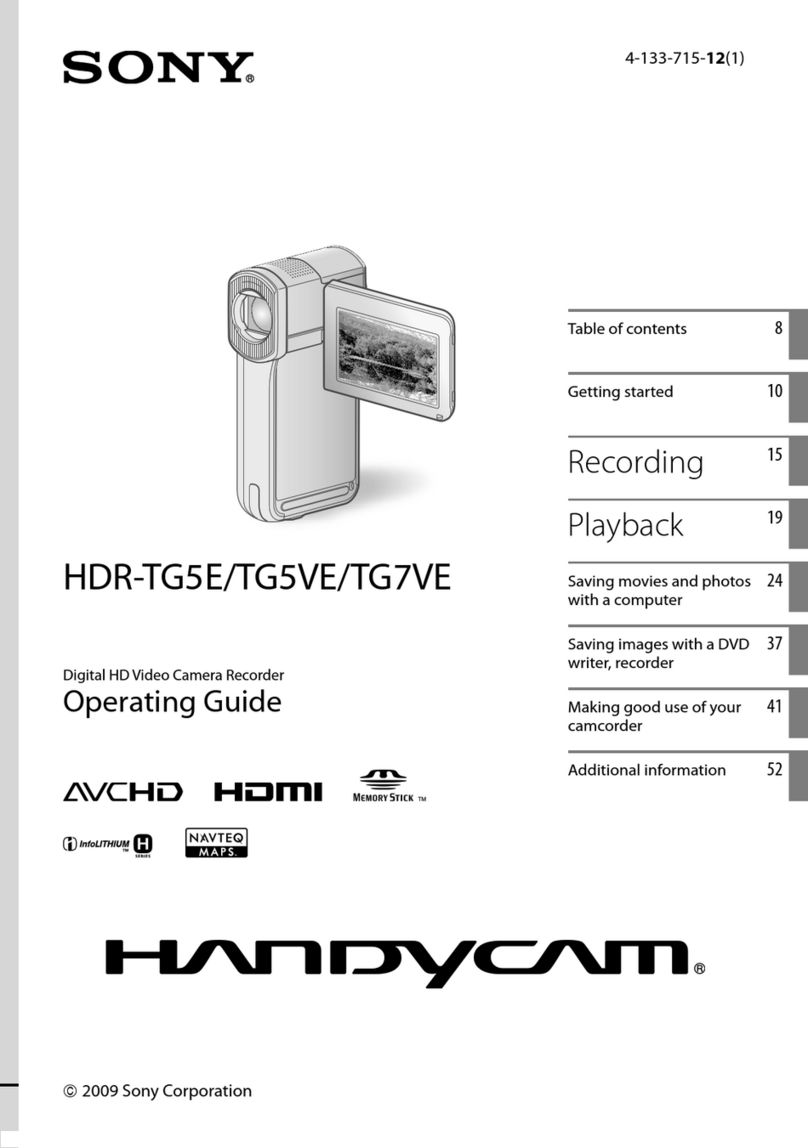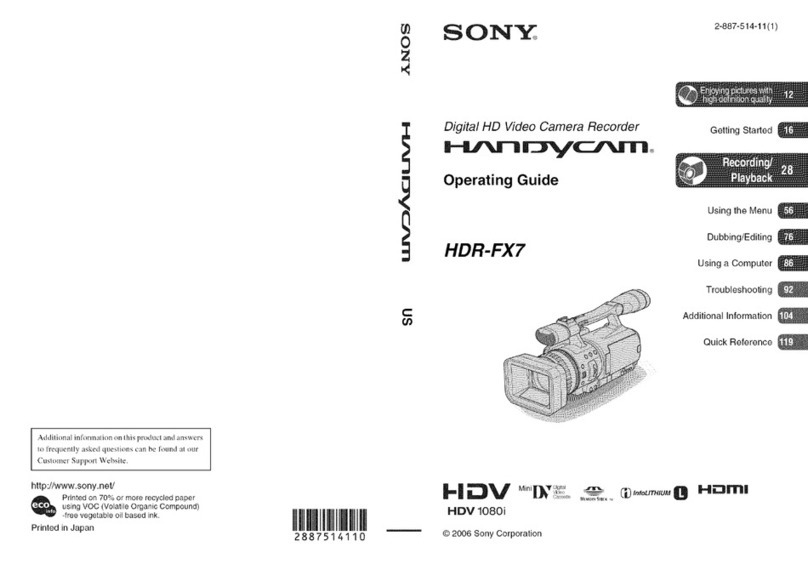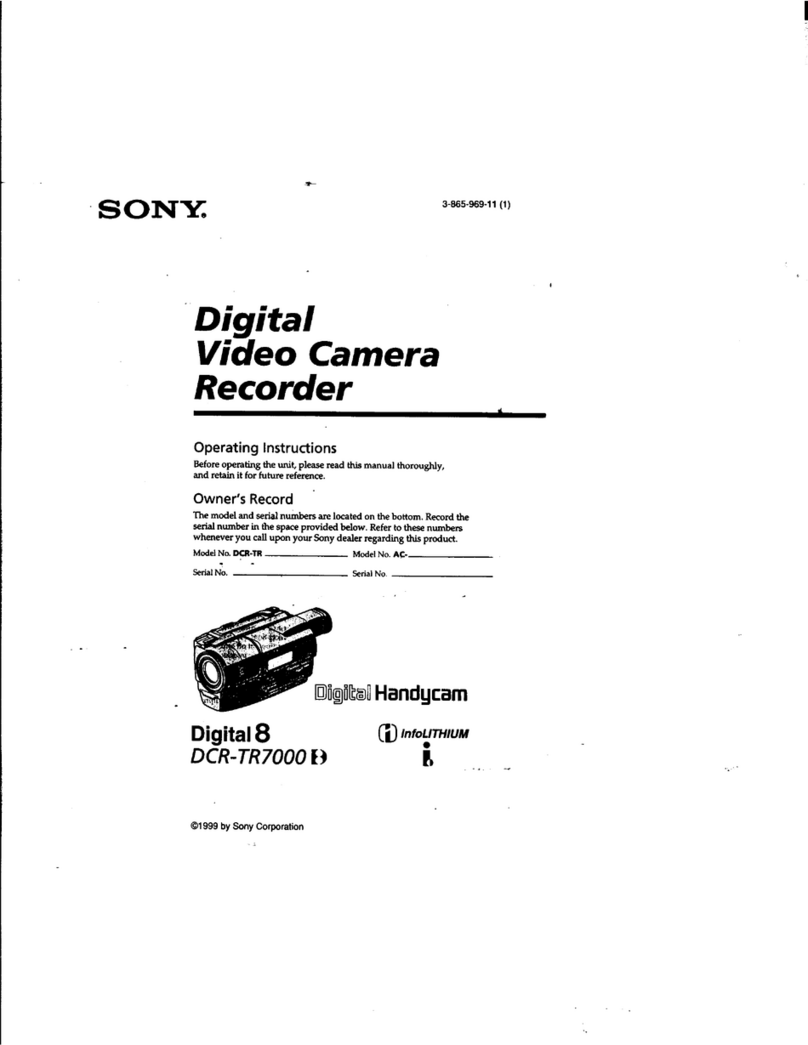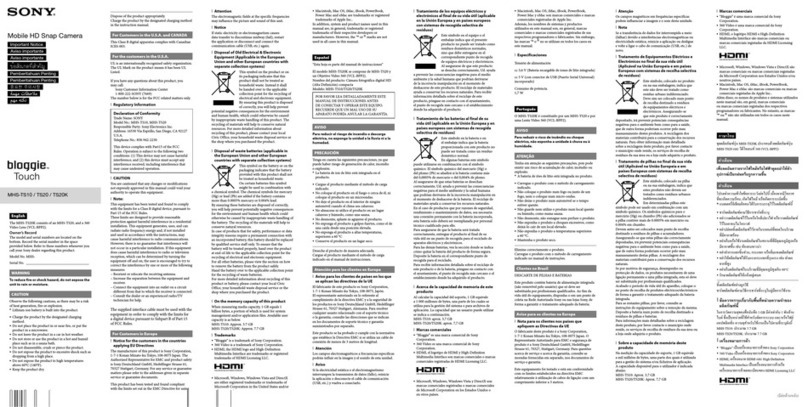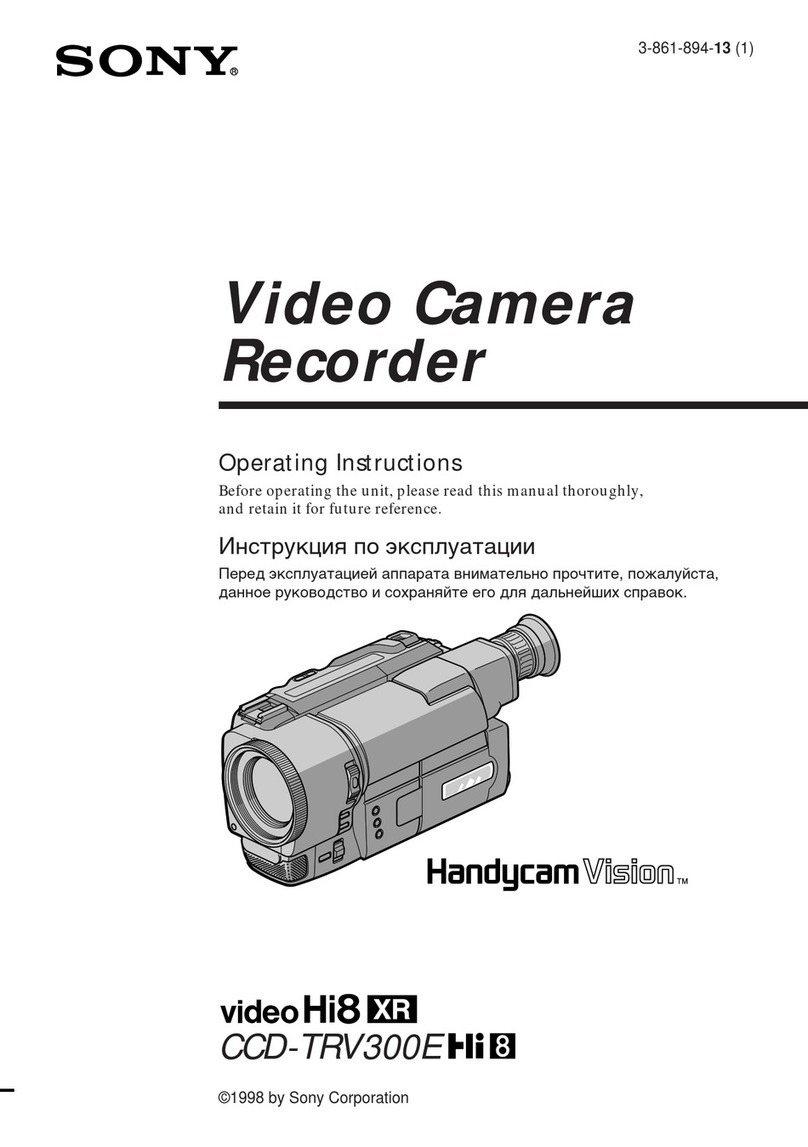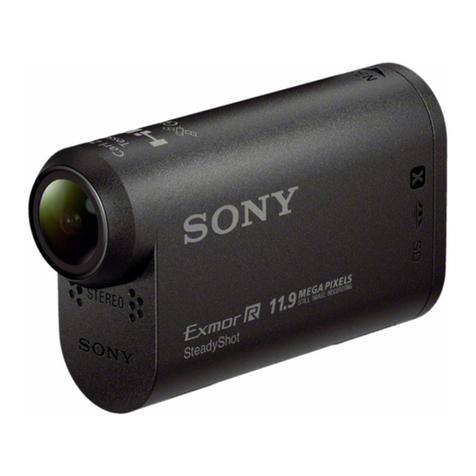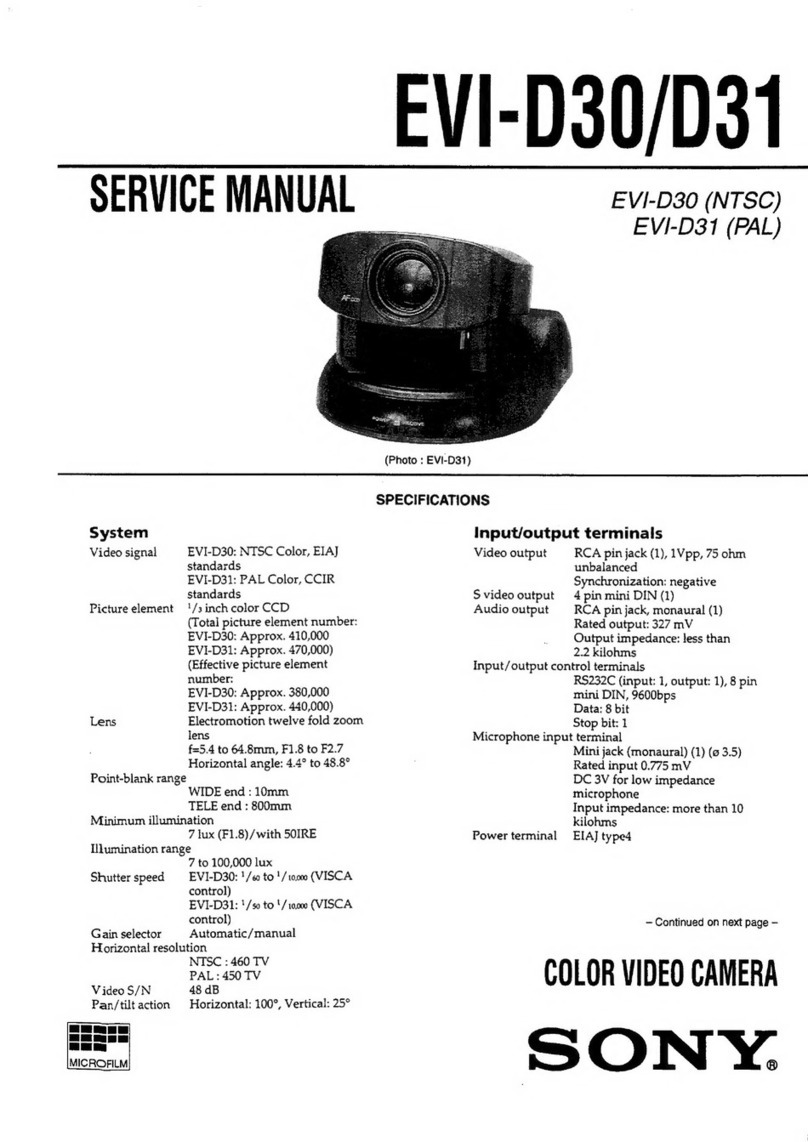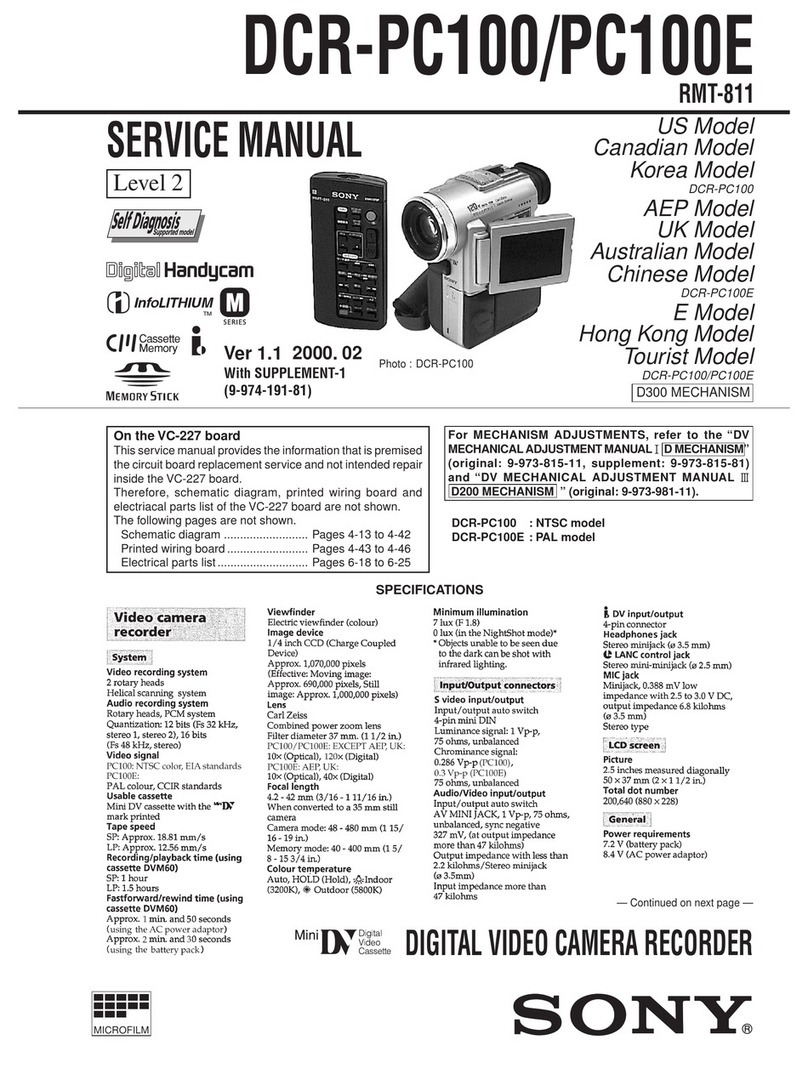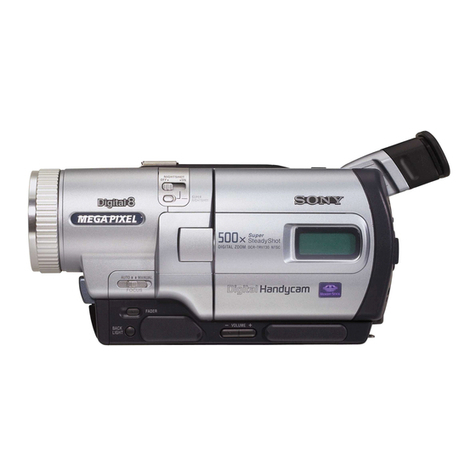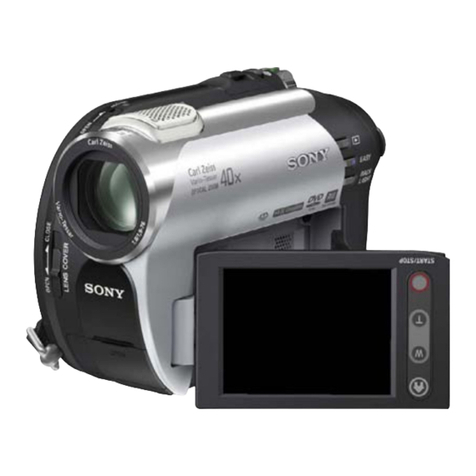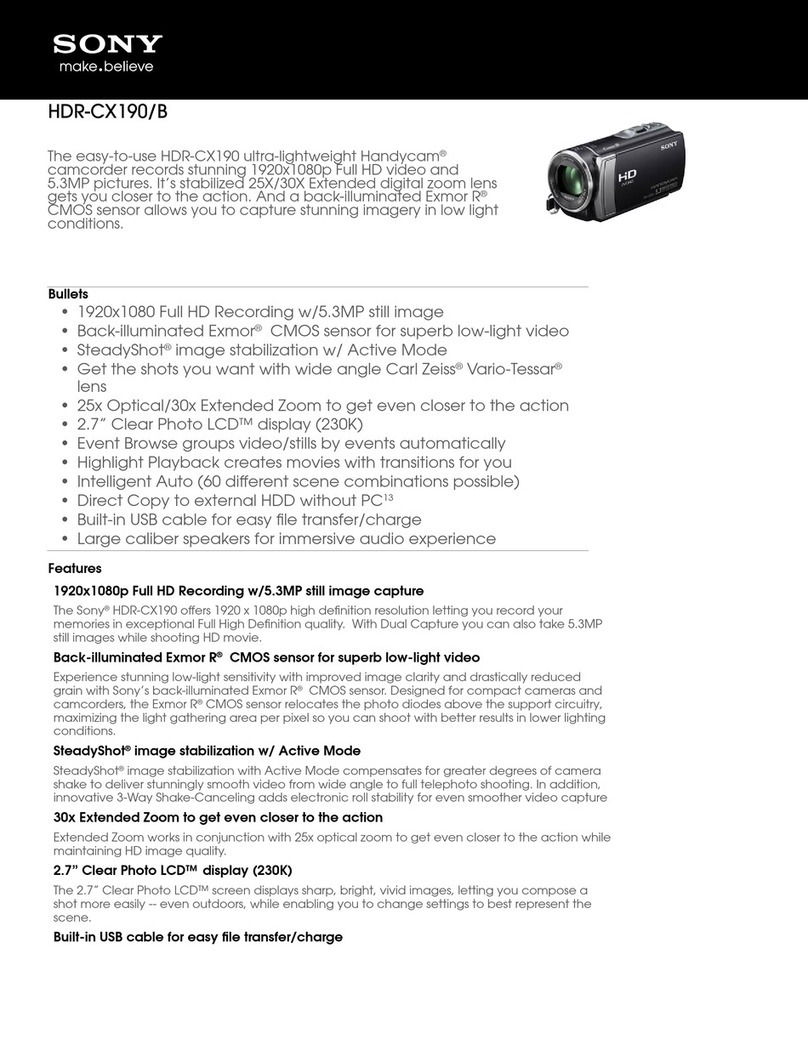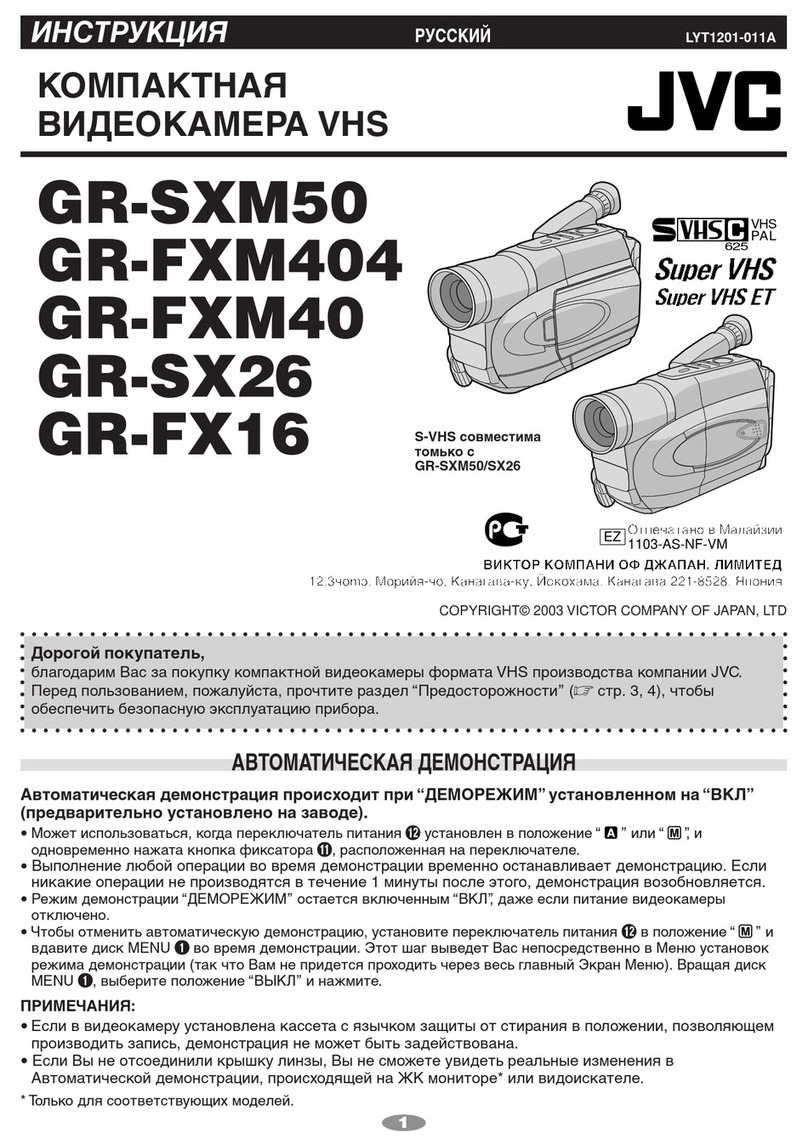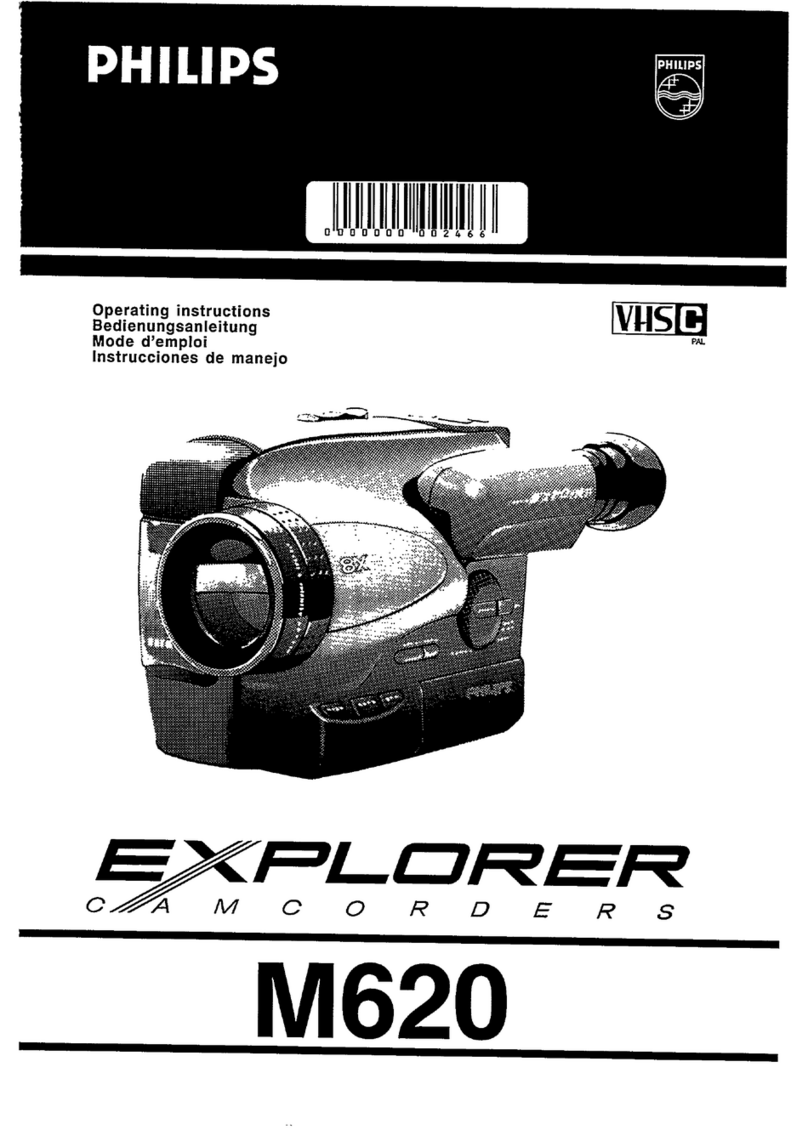
Note
Set this switch to OFF when using the camera in the normal way;
otherwise, the camera image may flutter.
VIDEO OUT (video output) connector
MONITOR output jack
Connect this jack to a video input connector of a video monitor. You can adjust
the camera or lens while looking at the image on the video monitor. After
adjusting the camera or lens, disconnect the cable.
EXT CTRL (external control input/output) connector
PHASE adjustment screw
Use this screw to adjust the vertical phase in Line Lock mode.
Camera installation hole (2 positions)
Make sure to tighten the screws securely when installing the camera.
AC/DC (power input) connector
Safety cord
This safety cord prevents the dome casing from falling down from the camera unit.
Hook
The safety cord is factory installed to pass under the hook inside the camera unit.
Dome casing
The dome casing is made of polycarbonate. A waterproof rubber gasket is
provided on the joint surface to the dome casing.
Connecting the Cables
1Connect the BNC cable to a monitor or video device (see figure ).
2Connect the I/O cable to external control signals (see figure ).
3Connect the power cable to the power supply (AC 24 V/DC 12 V)
(see figure ).
Caution
When you have connected the power cable, be sure that the exposed ends of
the power cable do not touch each other to prevent a short circuit.
(continued on the reverse side)
中文
使用本机前,请仔细阅读本使用手册并妥善保存以备日后参考。
警告
为防止触电严禁拆开机壳,维修请咨询具备资格人
士。
注意事项
额定标签位于底部。
电源
SSC-CM565R运⾏在24 V交流或12 V直流上。
SSC-CM565R⾃动侦测电源。
警告
此为A级产品。在⽣活环境中,该产品可能会造成⽆线电⼲扰。在这
种情况下,可能需要用户对⼲扰采取切实可⾏的措施。
注意
某些特定频率的电磁场可能会⼲扰本机的图像。
关于旧产品的处理
请不要将旧的产品与一般的⽣活垃圾一同弃置。
正确弃置旧的产品有助于避免对环境和人类健康造成潜在的负面影
响。
具体处理方法请遵循当地的规章制度。
特性
这是一款采用1/3型EXview HAD CCD II™*的半球型摄像机。具有以
下特点:
手动设定摄像机方向-水平、垂直和旋转
Vari-focal auto iris镜头作为标准配置。镜头焦距从2.8 mm至
10.5 mm。
高分辨率和高灵敏度
⾃动白平衡追踪和调整(ATW/ATW-PRO)
降噪
日/夜功能可进⾏彩色/黑白模式切换
24 V交流/12 V直流电源系统
线路锁定功能(24 V交流)
* EXview HAD CCD II™是Sony Corporation的商标。
使用须知
使用前
如果使用前发现有结露,请拆下圆顶外壳并保持摄像机打开直到结
露消失。
操作或存放场所
避免在以下位置使用或存放摄像机:
建议在屋檐下或者天花板上安装。
极热或极冷的地方(操作温度:
–10℃到+50℃)
靠近热源(例如加热器附近)
靠近强磁源的位置
靠近⽆线电或电视发射器等强电磁辐射源的地方
易于受到强力振动的地方
请勿直接用手触碰PCB基板
如果摄像机由于天气(如雨天)原因聚焦不良,请手动调节聚焦
易于结露和高湿的地方
存在煤烟或油污的地方
通风
为了避免热量积蓄,不要阻挡摄像机附近的通风。
运输
携带时务必关闭电源。
当运送摄像机时,重新以出厂时的包装进⾏包装,或用同等品质的
材质包装。
清洁
用吹灰器清除镜头灰尘。
使用柔软、⼲燥的布清洁摄像机的外表面。要清除顽固的污渍,
请用少量清洁剂蘸湿软布,然后擦⼲即可。
不要使用酒精、苯或稀释剂等挥发性溶剂,这些物质可能会破坏
表面光洁度。
在室外安装摄像机
将圆顶外壳牢固地安装到摄像机外壳上。
确保用密封剂(如硅胶密封剂)密封以下所列位置,以防止外壳内
部受潮。最好将摄像机安装在低湿度环境下。
摄像机安装孔 (2)
管孔(侧部/底部)
有关激光束的注意事项
激光束可能会损坏影像传感器。请注意:在使用激光束设备的环境
中,影像传感器的表面不得暴露于激光束辐射中。
典型CCD现象
图像中可能出现的以下现象是CCD(电荷耦合器件)图像传感器所特
有的。这些现象不是故障。
白斑
虽然CCD图像传感器是采用高精度技术⽣产的,但由于宇宙射线等的
影响,其屏幕上可能会出现细小的白斑(极少数情况)。
这与CCD图像传感器的原理有关,出现的白斑并不是故障。
在以下情况中,比较容易出现白斑:
在高温环境下操作时
提高倍率(灵敏度)时
当使用慢快门时
垂直拖影
拍摄亮度极高的物体(如强聚光灯或闪光灯)时,屏幕上可能出现
垂直尾线,图像也可能出现扭曲。
图形失真
拍摄微小的图案、条纹或线条时,它们可能呈锯齿状或出现闪烁现象。
A
B
Operating Instructions
使用手册
Color Video Camera
半球型摄像机
4-413-934-31(1)
© 2011 Sony Corporation Printed in China
SSC-CM565R
English
Before operating the unit, please read this manual thoroughly and retain it for
future reference.
WARNING
To avoid electrical shock, do not open the cabinet.
Refer servicing to qualified personnel only.
CAUTION
The rating label is located on the bottom.
Power Supply
The SSC-CM565R operates on 24 V AC or 12 V DC.
The SSC-CM565R automatically detects the power.
For the customers in China
WARNING
This is a Class A product. In a domestic environment, this product may cause
radio interference in which case the user may be required to take adequate
measures.
This apparatus shall not be used in the residential area.
ATTENTION
The electromagnetic fields at the specific frequencies may influence the picture
of the unit.
Features
This is a dome-shaped color video camera for which the 1/3 type EXview HAD
CCD II™* has been adopted. It has the following features:
Manual setting of the camera direction - panning, tilting and rotating
Vari-focal auto iris lens fitted as standard. Lens focal length is from 2.8 mm to 10.5 mm.
High resolution and high sensitivity
Automatic white balance tracking and adjustment (ATW/ATW-PRO)
Noise Reduction
Day/Night function allowing color/monochrome mode switching
AC 24V/DC 12V power supply system
Line Lock function (AC 24V)
* EXview HAD CCD II™is a trademark of Sony Corporation.
Notes on Use
Before Use
If you find condensation before use, remove the dome casing and leave the
camera open until the condensation has gone.
Operating or storage location
Avoid operating or storing the camera in the following locations:
It is recommended to install the camera on the ceiling or under the eaves.
Extremely hot or cold places (operating temperature: –10°C to +50°C
Close to heating equipment (e.g., near heaters)
Close to sources of strong magnetism
Close to sources of powerful electromagnetic radiation, such as radios or TV
transmitters
Locations subject to strong vibration or shock
Don’t touch the PCB board by hand directly
If the camera does not focus well because of the weather (such as rain), adjust
the focus manually
Locations subject to condensation and high humidity
Locations subject to soot or oil stains
Ventilation
To prevent heat buildup, do not block air circulation around the camera.
Transportation
Always turn off the power when carrying.
When transporting the camera, repack it as originally packed at the factory or in
materials of equal quality.
Cleaning
Use a blower to remove dust from the lens.
Use a soft, dry cloth to clean the external surfaces of the camera. Stubborn
stains can be removed using a soft cloth dampened with a small quantity of
detergent solution, then wipe dry.
Do not use volatile solvents such as alcohol, benzene or thinners as they may
damage the surface finishes.
To install the camera outdoors
Attach the dome casing securely to the unit casing.
Make sure you seal the locations listed below with sealant (e.g., silicone sealant)
to prevent moisture from getting inside the casing. It is better to install the
camera in an environment of low humidity.
Camera installation holes (2)
Conduit holes (side/bottom)
Note on laser beams
Laser beams may damage image sensors. You are cautioned that the surface of
image sensors should not be exposed to laser beam radiation in an environment
where a laser beam device is used.
Typical CCD phenomenon
The following phenomena that may appear in images are specific to CCD
(Charge Coupled Device) image sensors. They do not indicate malfunctions.
White flecks
Although the CCD image sensors are produced with high-precision technologies,
fine white flecks may be generated on the screen in rare cases, caused by cosmic
rays, etc.
This is related to the principle of CCD image sensors and is not a malfunction.
The white flecks especially tend to be seen in the following cases:
when operating in a high environmental temperature
when you have raised the gain (sensitivity)
when using the slow shutter
Vertical smear
When an extremely bright object, such as a strong spotlight or flashlight, is being
shot, vertical tails may be produced on the screen, or the image may be distorted.
Aliasing
When fine patterns, stripes, or lines are shot, they may appear jagged or flicker.
Location and Function of Parts
Side
Cables and are connected when the unit comes from the factory.
Power cable
Connect the power cable to AC 24 V or DC 12 V ( ). The connector tip is a
quick-disconnect type. The cable can be lengthened by attaching an extension
cable to the connector tip at the end of the cable.
BNC cable
Connect the BNC cable to a monitor or video device ( ).
Note
The output image is mainly used to adjust the view angle, and may not be
displayed correctly, depending on the video format and image size settings.
The image may not be displayed properly in the horizontal and/or vertical
plane.
The image size may be reduced.
I/O cable
Connect the I/O cable to external control signals ( ).
White: EXTERNAL CTRL OUT: H (+5 V) is output between this terminal and COM
when the color mode is selected; L (0 V) is output when the B/W mode is
selected.
Black: COM
Red: EXTERNAL CTRL IN: When H (+5 V) is applied between this terminal and
COM, the color mode is selected; when L (0 V) is applied, B/W mode is selected.
Notes
For external control signal connection, set the D/N switch to OFF.
Insulate the three wire ends of the I/O cable to avoid a short circuit when not
in use.
Wiring slot
Feed the fall-prevention rope through this.
For details, see “Installing the Camera” on the reverse side.
Camera head holder
Camera head fixing screw
First loosen the screw and face the camera head in the desired direction, then
tighten the screw to secure it.
Conduit holes
Connect a pipe to this hole. There are two conduit holes on the unit casing, one
on the side and one at the bottom. The conduit hole cover is plugged on the side
conduit hole. Remove it as needed and connect the pipe to the hole.
Zoom lever
Loosen the top of the lever, and move it to adjust the angle of view. Tighten the
top of the lever to secure its position.
Focus lever
Loosen the top of the lever, and move it to adjust the focal length. Tighten the
top of the lever to fix its position.
Lens
Note
Take care not to trap the cables between the camera and the ceiling or the wall. If
the cables are trapped, they may break and cause fire or electric shock.
Inside
Camera unit
Mode setting DIP switch
The following DIP switches are turned on if they have been set to the top
positions.
Pin No. Switch Location
Up (ON) Down (OFF)
1 SYNC LL INT
2 AGC ON OFF
3 iBLC ON OFF
4 ATR-Lite ON OFF
5 SHARPNESS SHARP NORMAL
6 WB ATW PRO ATW
7 D/N AUTO OFF
8 D/N_TIME SHORT LONG
9 AdIR ON OFF
0 IRIS OPEN AUTO
1: SYNC (Sync Lock) switch (Initial setting: INT)
Use this switch to set the camera synchronization mode to INT (Internal)
or LL (Line Lock).
When the camera power is DC 12 V, the camera is in the internal operation
mode regardless of the switch setting.
Note
If the Line Lock function is used while camera power is unstable, the
camera image may flutter.
2: AGC (Automatic Gain Control) switch (Initial setting: ON)
Use this switch to increase the gain of the video amplifier when set to ON.
3: iBLC (Intelligent Backlight Compensation) switch (Initial setting: OFF)
Use this switch to adjust the exposure to compensate for situations where
the subject is lit from behind.
4: ATR-Lite (Adaptive Tone Reproduction) switch (Initial setting: OFF)
When the switch is set to ON, the camera will adjust the tone
automatically according to ambient brightness and darkness.
5: SHARPNESS switch (Initial setting: NORMAL)
When the switch is set to ON, the camera will produce sharper images.
6: WB( White Balance) switch (Initial setting: ATW)
Choose the WB mode of the camera:
ATW PRO (when the switch is set to ON): the camera will adjust the
WB automatically, based on the color temperature of fluorescent,
incandescent or natural light.
ATW (when the switch is set to OFF): the camera will adjust the WB
automatically, especially under certain lights, such as sodium, etc..
7: D/N (Day/Night) switch (Initial setting: AUTO)
Choose the D/N mode of the camera:
D/N mode (when the switch is set to ON): switches to the color mode
when in a brightly lit environment; switches to the monochrome mode
when in a low light environment.
Color mode (when the switch is set to OFF)
8: D/N_TIME (Day/Night time) switch (Initial setting: LONG)
Sets the time for switching Day/Night mode.
SHORT takes more than 2 seconds, and LONG takes more than 30 seconds.
9: AdIR (Advanced IR control) switch (Initial setting: ON)
When the switch is set to ON, the camera will compensate for
overexposure in Night mode.
10: IRIS (Lens iris control) switch (Initial setting: AUTO)
When the switch is set to ON, the aperture is completely open, which
allows for easier focusing.
各部件的位置和功能
侧⾯
摄像机出厂时已连接电缆 、 和 。
电源电缆
将电源电缆连接至24 V交流电源或12 V直流电源( )。连接器端为
快速断线型。在电缆末端的连接器上安装延长线可加长电缆。
BNC电缆
将BNC电缆连接至监视器或视频装置( )。
注意
根据视频格式和图像尺寸设定而定,输出图像主要用于调节视角并
且可能⽆法正确显示。
图像可能⽆法在水平和/或垂直面上正确显示。
图像尺寸可能会缩小。
I/O电缆
将I/O电缆连接至外部控制信号( )。
白色:EXTERNAL CTRL OUT:选择彩色模式时在本端子和COM之间输
出H (+5 V);选择黑白模式时输出L (0 V)。
黑色:COM
红色:EXTERNAL CTRL IN:选择彩色模式时在本端子和COM之间应用
H (+5 V);选择黑白模式时应用L (0 V)。
注意
外部控制时,必须将D/N开关设定为OFF。
不使用时,使I/O电缆的三个导线端绝缘以免短路。
布线槽
将防坠绳穿入此槽。
更多详情,请见反面的“安装摄像机”。
摄像机头架
摄像机头固定螺钉
先松开螺钉并将摄像机头部朝向所需方向,然后拧紧螺钉以固定。
管孔
将管子连接到此孔。摄像机外壳上有两个管孔,一个在侧部,另一
个在底部。侧管孔上插有管孔盖。根据需要将其拆下,将管子连接
至该孔。
变焦杆
松开此杆顶部,移动此杆调节视角。拧紧此杆顶部固定其位置。
聚焦杆
松开此杆顶部,移动此杆调节焦距。拧紧此杆顶部固定其位置。
镜头
注意
小心不要让电缆夹在摄像机和天花板或墙壁之间。如果夹到电缆,
可能会由于断裂而造成起火或触电。
内部
摄像机
模式设定DIP开关
如果下列DIP开关被设定于顶端位置,则它们处于打开状态。
Pin No. 开关 位置
上(ON) 下(OFF)
1 SYNC LL INT
2 AGC ON OFF
3 iBLC ON OFF
4 ATR-Lite ON OFF
5 SHARPNESS SHARP NORMAL
6 WB ATW PRO ATW
7 D/N AUTO OFF
8 D/N_TIME SHORT LONG
9 AdIR ON OFF
0 IRIS OPEN AUTO
1: SYNC (同步锁定) 开关(初始设定:INT)
使用此开关将摄像机同步模式设定为INT(内部)或LL(线路
锁定)。
摄像机电源为12 V直流电源时,摄像机以内部操作模式工作,
而不管开关设定位置。
注意
如果在摄像机电源不稳定时使用线路锁定功能,摄像机画面可
能会抖动。
2: AGC(自动增益控制)开关(初始设定:ON)
设定为ON时,可使用此开关以提高视频放大器的增益。
3: iBLC(智能逆光补偿)开关(初始设定:OFF)
使用此开关对处于逆光环境的拍摄对象进⾏曝光补偿。
4: ATR-Lite(适应性色调再生)开关(初始设定:OFF)
此开关设定为ON时,摄像机将根据环境明暗⾃动调节色调。
5: SHARPNESS(锐度选择)开关(初始设定:NORMAL)
此开关设定为ON时,可以提高摄像机画质的锐度。
6: WB(白平衡)开关(初始设定:ATW)
选择摄像机的WB模式:
ATW PRO(此开关设定为ON时):摄像头根据荧光灯、白炽灯
或⾃然光线的色温⾃动调节WB。
ATW(此开关设定为OFF时):摄像机⾃动调节WB,特别是在钠
灯等特定光源下。
7: D/N(日/夜)开关(初始设定:AUTO)
选择摄像机的D/N模式:
D/N模式(此开关设定为ON时):在明亮的环境中切换到彩色
模式;在低亮度的环境中切换到黑白模式。
彩色模式(此开关设定为OFF时)
8: D/N_TIME(日/夜时间)开关(初始设定:LONG)
设定切换日/夜模式的时间。
采用选项“SHORT”时,需要2秒以上,采用选项“LONG”时,
需要30秒以上。
9: AdIR(高级IR控制)开关(初始设定:ON)
此开关设定为ON时,可以抑制黑夜模式下的曝光过度现象。
10: IRIS(镜头光圈控制)开关(初始设定:AUTO)
此开关设定为ON时,光圈完全打开,便于对焦。
注意
正常使用摄像机时将此开关设定为OFF;否则摄像机画面可能
会抖动。
VIDEO OUT(视频输出)接口
MONITOR输出插孔
将此插孔连接到视频监视器的视频输入接口。您可以在视频监视器
上一边观看图像,一边调节摄像机或镜头。调节摄像机或镜头以
后,断开电缆连接。
EXT CTRL(外部控制输入/输出)接口
PHASE调节螺钉
使用此螺钉调节线路锁定模式中的垂直相位。
摄像机安装孔(2 点)
确保安装摄像机时要拧紧螺钉。
AC/DC(电源输入)接口
防护绳
此防护绳可防止圆顶外壳从摄像机上掉落。
挂钩
出厂时安装有防护绳,穿在摄像机内侧挂钩下。
圆顶外壳
圆顶外壳由聚碳酸酯制成。圆顶外壳的接缝面上有一层防水橡胶垫片。
连接电缆
1 将BNC电缆连接至监视器或视频装置(参见图 )。
2 将I/O电缆连接至外接控制信号(参见图 )。
3 将电源电缆连接至电源插座(24 V交流电源/12 V直流电源)
(参见图 )。
注意
为防止发⽣短路,连接电源线时,请勿使电源线裸露端相互接触。
(接反面)



